
Dec 25, 2025
- Products & Solutions
- Stories
- Technology
- AI & Robotics
- R&D
- Business Solutions
Aug 08, 2017
Products & Solutions / Press Releases
- World-leading Hospitality Enters Trial Phase at 'Gateway to Japan' -

Tokyo International Air Terminal Corporation (TIAT; Head Office: Ota-ku, Tokyo; President & CEO: Katsuji Doi), Japan Airport Terminal Co., Ltd. (JAT; Head Office: Ota-ku, Tokyo; President & COO: Nobuaki Yokota), Nippon Telegraph and Telephone Corporation (NTT; Head Office: Chiyoda-ku, Tokyo; President & CEO: Hiroo Unoura) and Panasonic Corporation (Panasonic; Head Office: Kadoma, Osaka; President: Kazuhiro Tsuga) will begin public testing of information universal design initiatives.
With the international terminal at its core, Haneda Airport has implemented universal design concepts to promote the development of airports that cater to all individuals. Looking ahead to 2020 and beyond, we can expect further increase in not only foreign visitors but also the number of customers requiring mobility support as the population continues to age. As such, we believe integrating the latest information technology (ICT) is essential to advancing universal design, and have been striving to do so through various initiatives since December 2015. With such efforts showing steady results, we have now established an environment for real-world application through public testing by Haneda Airport customers.
As the gateway to Japan, Haneda Airport receives many customers, with the number expected to rise as foreign visitors continue to increase. Initially, public testing will give these customers a chance to experience Japan's cutting-edge technology; we hope to utilize their diverse comments and feedback to create valuable tools for greater use both in and outside the airport.
As part of progressive efforts in universal design, Haneda Airport is striving to ensure user-friendliness for all of its increasingly diverse customers. We consider the integration of universal design and various information technologies an urgent task, and these public trials provide an important opportunity to ascertain the effectiveness of each technology.
Having so far conducted tests involving only airport staff, we hope that real-world use by numerous customers will serve as the final phase in creating reliable technologies.
| Test period: | Tuesday August 8, 2017 - Saturday March 31, 2018 | |
| Test location: | Haneda Airport International and Domestic Terminals | |
| Test content: | <NTT> | • Kazashite Guidance™ functions on TIAT official website (Multilingual/multicultural support for restaurant menus, facility navigation from information signs) • Measurement/forecasting of congestion at international departure screening gates and mobile signs to manage passenger flows • Implementation of audio signage equipment with noise-reducing technology |
| <Panasonic> | • Autonomous mobility via Robotic Electric Wheelchair WHILL NEXT • Transport information for foreign visitors, utilizing LinkRay™ technology | |
Employing corevo®*1 AI technology, NTT will conduct trials to improve information universal design using ICT.
Valuable information can be obtained in one's native language by simply pointing a smartphone camera at signage and other objects. This not only allows multilingual browsing of transport and other information, but also includes multidimensional maps*2 to promptly identify the user's current location within the terminal; route guidance with consideration for universal design; and introductions to unfamiliar aspects such as Japanese food.
By using the Kazashite Guidance™ function via the official TIAT website, we have now simplified the process for passengers by not requiring the installation of apps. Available content in the initial phase includes guidance and information signage, as well as menus at select restaurants; we plan to expand the service to include all restaurant menus and tourism posters by the end of FY2017.
Based on usage rates and passenger feedback in the public trials, we will make the interface and content more user-friendly ahead of launching the service.
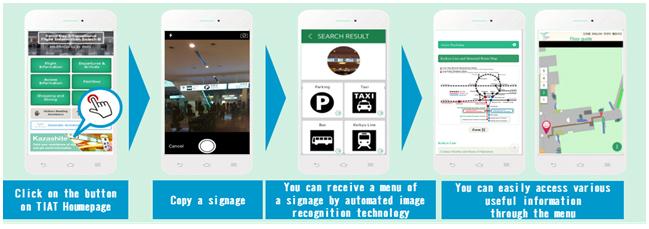
Employing image recognition technology for automated measurement of passenger flows from camera footage, this system will also use projectors and digital signage to automatically change display content according to real and forecast congestion. This enables information to be designed for easy communication to many people, including adjustment of display language based on conditions in specific areas and varying display location according to the extent of external light.
These public trials will be used to evaluate the accuracy of congestion measuring/forecasting at international departure screening gates and to confirm the effects of leveling congestion, with the aim of preparing the service for launch.
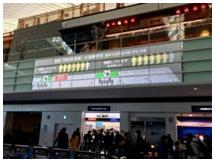 Guidance sign
Guidance sign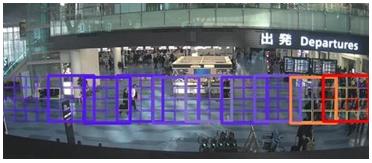 Camera crowd analysis
Camera crowd analysisAchieves clear voice guidance without increasing volume, even in noisy surroundings. Testing will be used to confirm the effectiveness of offering noise-reducing audio for those with impaired vision, using the airport's existing voice guidance equipment and pre-recorded ambient sounds.
Developed through a collaboration between Panasonic and WHILL Inc., the WHILL NEXT is a mobility robot that enables safe, comfortable transport for Passengers with Reduced Mobility (PRM), whose use of airports is expected to increase.
This year, we will conduct technical trials of the ① Automatic Stop, ②Autonomous Mobility and ③Tandem Movement functions within the airport. With the cooperation of airlines, we will also test ways to reduce the burden on staff and improve customer convenience.
*In the development of this technology, we have also received a grant from the New Energy and Industrial Technology Development Organization (NEDO).

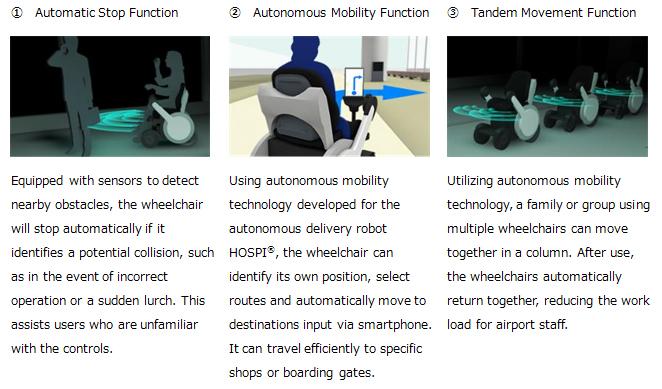
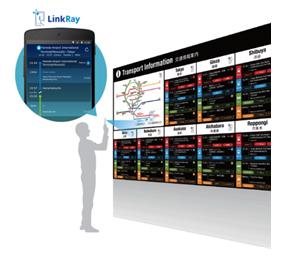
Public transport information at airports is a source of difficulty for two-thirds of foreign visitors*; focusing on this, a joint project with route-information provider Jorudan has led to the design of transport information signage linked to smartphones via LinkRay technology. The trial will test the effectiveness of one-stop, multilingual transport information that allows foreign travelers arriving at the airport to easily select their ideal mode of transport.
With the cooperation of Keikyu Corporation, LinkRay Spotlight will also be available at the Haneda Airport International Terminal Station, allowing users to search and obtain multilingual route information for their destination by simply pointing a smartphone at the network map above the ticket machines.
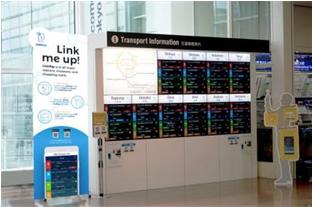 Transport Information Signage (TIAT 2F Arrival lobby
Transport Information Signage (TIAT 2F Arrival lobby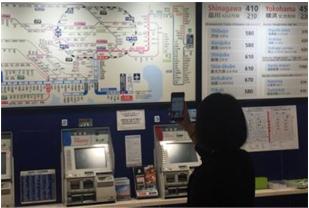 LinkRay Spot at the Railway Network Map
LinkRay Spot at the Railway Network Map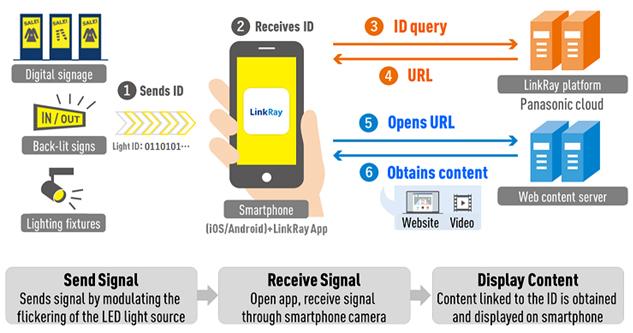
The results of this public testing will be used to implement/adopt ICT in preparation for 2020 and beyond. We will also continue to seek corporate partners to participate in joint trials.
The content in this website is accurate at the time of publication but may be subject to change without notice.
Please note therefore that these documents may not always contain the most up-to-date information.
Please note that German, Spanish and Chinese versions are machine translations, so the quality and accuracy may vary.